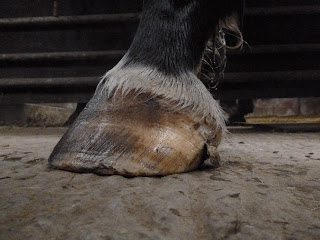Ironically, many farriers and trimmers look to the mustang hoof as a sort of holy grail. Trimming a hoof to make it appear like a mustang hoof is sometimes used as a justification for changing angles, heel height, breakover and all sorts of other aspects of the external hoof.
Its as if we believe that if we make it look like a mustang hoof it will somehow function like a mustang hoof. But appearance is far from being everything, and in my experience changing how a hoof looks - without paying a great deal of attention to the more important question of how the hoof is landing, loading and supporting the limb - can be counter-productive.
But there are important lessons to be learned from mustang hooves, because the horses who have them cover huge mileage on tough terrain and something is obviously working.
I was therefore intrigued and delighted to find these photos of hooves belonging to Wyoming mustangs:
http://mollyshoofjourney.blogspot.co.uk/2013/03/some-mustang-hooves.html
and here:
http://mollyshoofjourney.blogspot.co.uk/2013/03/medial-flare.html
The horse above has a very similar medial deviation to Dexter's, which so many well-meaning people would love to trim off(!) and the horse below has a similar toe profile to Charlie, who like the mustangs has covered many miles, very happily, with his apparently "abnormal" hoof.
The important thing about these hooves is that they belong to horses who are sound, healthy and thriving in a harsh environment - in contrast to the apparently "perfect" mustang cadaver hooves which we are more used to seeing - and they pose some rather interesting questions about whether what we think of as "correct" or "normal" really IS what the horse requires.
Perhaps its us who should be adjusting our perceptions, before we attempt to adjust our horses' hooves!































































